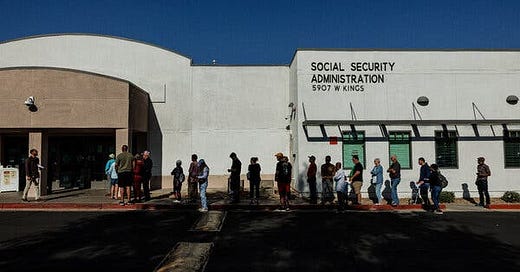Last Wednesday, the trustees of the Social Security Trust Fund issued their annual report, which predicted that the Trust Fund will run out of funds in 2033—just eight years away. When this occurs, social security payments will continue, but benefits would be reduced by 23% across the board unless Congress acts. This may actually be an optimist report. The assessment predicts that there will be an increase in the fertility rate, which many analysts think is unrealistic. In addition, the Trump crackdown on immigration could also lead to reductions in the trust fund since these immigrants pay into the system, but receive no benefits.
The problem largely arises from the fact that the ratio of workers (paying into the trust fund) to retirees (getting benefits out of the system) has gone from 5 to 1 in 1960 to 3 to 1 now, and is expected to go to 2 to 1 by 2035. In 1986, a reform effort successfully solved the problem, but after 40 years more changes are needed to keep the Trust Fund solvent.
Almost no one thinks that the 23% cut would occur. This benefit cut would be hugely unpopular and politicians simply won’t survive politically if they took no action. Still, the sooner we take steps to address the problem, the less painful the solutions will be. Sadly, in the current environment, reform is simply no going to happen. Republicans insist on no tax increases, and Democrats insist on no benefit cuts (and no tax increases on those making $400,000 or less). The math of the problem, however, requires both benefit adjustments and revenue increases. The challenge is that in the current political environment, both parties seem focused on proving free stuff and tax breaks to help voter blocks rather than making tough choices to solve real problems.
My prediction is that sometime in the early 2030’s Congress will be forced to act. In the meantime, it might be useful to get informed by the various options.
I have been playing with a useful interactive tool produced by the Committee for a Responsible Federal Budget, and it is clear to me that a deal is possible if both sides are willing to compromise. For example, most Democrats oppose increasing the retirement age for full benefits because this is unfair to lower wage employees who generally have more back breaking jobs. This can be ameliorated, however, by changing the benefit formula so that the age increase for full benefits is offset by a more generous benefit formula at the lower income levels.
So what are the possible reform options?
On the revenue side, progressives note that the obvious target is the cap on wage income that is subject to social security taxation (now about $176,000). This alone, however would not be sufficient to close the gab, but it could make a major contribution. If the cap was removed altogether, this would eliminate 56% of the Trust Fund gap, and even more if the increased wages were not included in benefit calculations. Even a more modest increase in the cap to 90% of all wages (the current cap is at 83%) would raise enough funds to close 25% of the gap. Any increase in the cap, however, would be very challenging. For the higher income employees affected by the increase in the cap, this would mean a 30% or more increase in total federal tax liability. This would have adverse economic effects and would be politically challenging.
Other revenue options include a tax on investment income, an increase in the social security tax rate (each 0.1 percentage point increase closes 3% of the gap).
Republicans like to focus on the benefit side, but these too are not sufficient by themselves to close the gap. Changes to the benefits offered the top 20% earners could close 11% of the gap. Indexing the age for full benefits to longevity could close 20% of the gap. Raising the age to 69 (and then indexing) could close 39% of the gap. Change the COLA formula to the Chained CPI could close 19% of the gap.
If you are concerned about the effect of these changes on low and moderate income Americans, there can be offsetting benefit changes. For example, you could set the minimum benefit at 125% of the poverty rate at a cost of adding 3% to the gap.
I played with the CFRB interactive tool and came up with a set of changes that closed the gap and kept the Trust Fund solvent for 75 %. Yea me! I urge you to play withe the tool as well.
This is a solvable problem. We faced the problem in the 1980’s and saved the trust fund for over 40 years. there is no free lunch here. Both benefit adjustments and revenue increases will be needed. There will need to be compromises. And the first step is educating ourselves about the true trade offs.




